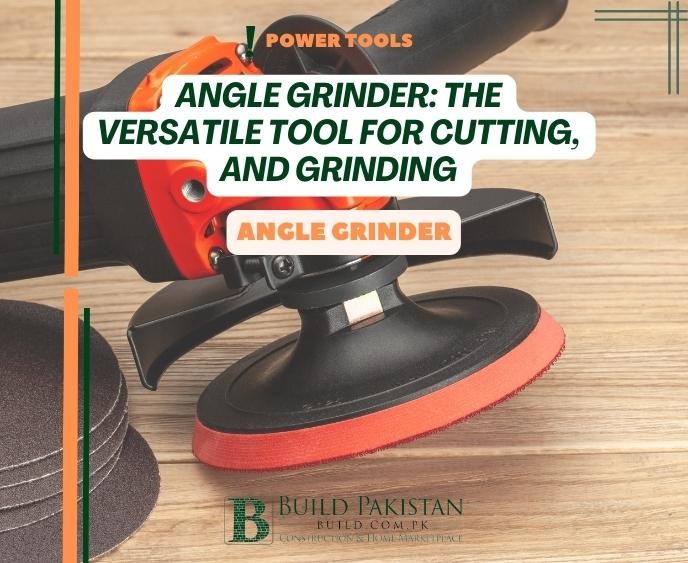Angle Grinder: The Versatile Tool for Cutting and Grinding

Introduction:
An angle grinder is a versatile power tool used for cutting,
grinding, and polishing materials such as metal, concrete, and tile. It
consist of a motor that drives a spinning abrasive disc or wheel, which can be
changed according to the task at hand. Angle grinders are commonly used in
construction, metalworking, and DIY projects due to their versatility and
power. In this blog, we will discuss the different aspects of an angle grinder
in detail.
History of Angle Grinders
Angle grinders have been around since the early 20th century,
where they were used primarily in the construction industry. The first angle
grinders were hand-cranked and were not very powerful. It wasn't until the
1950s that electrically powered angle grinders were introduced, making them
more accessible and efficient.

Parts of an Angle Grinder
An angle grinder consists of several parts that work together
to provide the desired outcome. These parts include:
Motor:
The motor is the main component of an angle grinder, which
drives the grinding wheel or disc. The motor's power and speed vary based on
the grinder's intended use.
Disc/Wheel:
The grinding disc or wheel is attached to the spindle of the
motor and rotates at a high speed, allowing it to cut through various
materials.
Guard:
The guard is a safety
feature that is used to protect the user from the rotating disc. It also helps
to prevent debris from flying out during use.
Handle:
The handle provides a
comfortable grip for the user, allowing them to control the angle grinder
during use.
Switch:
The switch is used to turn the angle grinder on and off.
Types of Angle Grinders
There are two main types of angle grinders: corded and
cordless.
Corded Angle Grinders:
Corded angle grinders are powered by electricity and must be
connected to an outlet for use. They are typically more powerful than cordless
angle grinders and are preferred for heavy-duty tasks.
Cordless Angle Grinders:
Cordless angle grinders are powered by rechargeable batteries
and are highly portable. They are perfect for tasks that require mobility, such
as working in tight spaces.
Uses of Angle Grinders
Angle grinders are highly versatile and can be used for a
variety of tasks. Some common uses include:
Cutting:
Angle grinders can cut through various materials, including
metal, concrete, and tile.
Grinding:
Angle grinders are
used to grind down and smooth rough surfaces.
Polishing:
Angle grinders can be
used to polish surfaces, such as metal or stone.
Sanding:
Angle grinders can be used for sanding, especially when
fitted with sanding discs.
Benefits of Angle Grinders
Angle grinders offer several benefits, including:
Versatility:
Angle grinders can be
used for a variety of tasks, making them a versatile tool.
Power:
Angle grinders are powerful tools that can cut through tough
materials.
Speed:
Angle grinders can complete tasks quickly due to their high
speed.
Efficiency:
Angle grinders are efficient tools that can save time and
energy on tasks.
Drawbacks of Angle Grinders
Despite their benefits, angle grinders also have some
drawbacks, including:
Safety:
Angle grinders can be
dangerous if not used properly, and users must take precautions to prevent
injury.
Noise:
Angle grinders are
loud and can produce a significant amount of noise during use.
Dust:
Angle grinders produce
a lot of dust and debris during use, which can be harmful if inhaled.
Price:
Angle grinders can be
expensive, especially for high-end models with advanced features.

Maintenance and Safety Precautions
No matter how skilled and experienced you are with an angle
grinder, it’s essential to follow proper maintenance and safety procedures.
Here are some tips to help you avoid accidents and ensure your tool stays in
top shape:
Maintenance:
- Always disconnect the tool from the power source before
changing accessories or performing maintenance.
- Clean the tool regularly to prevent dust and debris buildup.
- Keep the air vents clean to prevent overheating and ensure
proper ventilation.
- Check the power cord for any damages, and replace it
immediately if you find any signs of wear and tear.
- Lubricate the moving parts with oil or grease to ensure
smooth operation.
- Store the tool in a dry and clean place, away from moisture
and dust.
Safety Precautions:
- Always wear personal protective equipment, including safety
glasses, gloves, earplugs, and a dust mask.
- Make sure the accessory is properly secured and tightened
before starting the tool.
- Use the correct size and type of accessory for the job.
- Do not use a damaged or worn accessory.
- Keep the work area clean and free of clutter to avoid
tripping hazards.
- Hold the tool with both hands and maintain a stable position
while operating.
- Never use the tool with one hand, as this can cause loss of
control.
- Be aware of the kickback effect and avoid putting excessive
pressure on the tool.
- Do not use the tool near flammable materials or in a confined
space.
- Always disconnect the tool from the power source before
making any adjustments or changing accessories.
Following these maintenance and safety procedures will help
you get the most out of your angle grinder while keeping yourself and others
safe.
Conclusion:
An angle grinder is a versatile tool that can be used for a
wide range of cutting, grinding, and polishing tasks. Whether you’re a
professional metalworker or a DIY enthusiast, an angle grinder is a must-have
in your toolkit. With the right accessory and proper technique, you can cut
through metal, concrete, and other materials with ease. However, it’s important
to follow safety precautions and maintenance procedures to prevent accidents
and ensure your tool stays in top shape. With these tips in mind, you can use
your angle grinder with confidence and achieve professional results.










